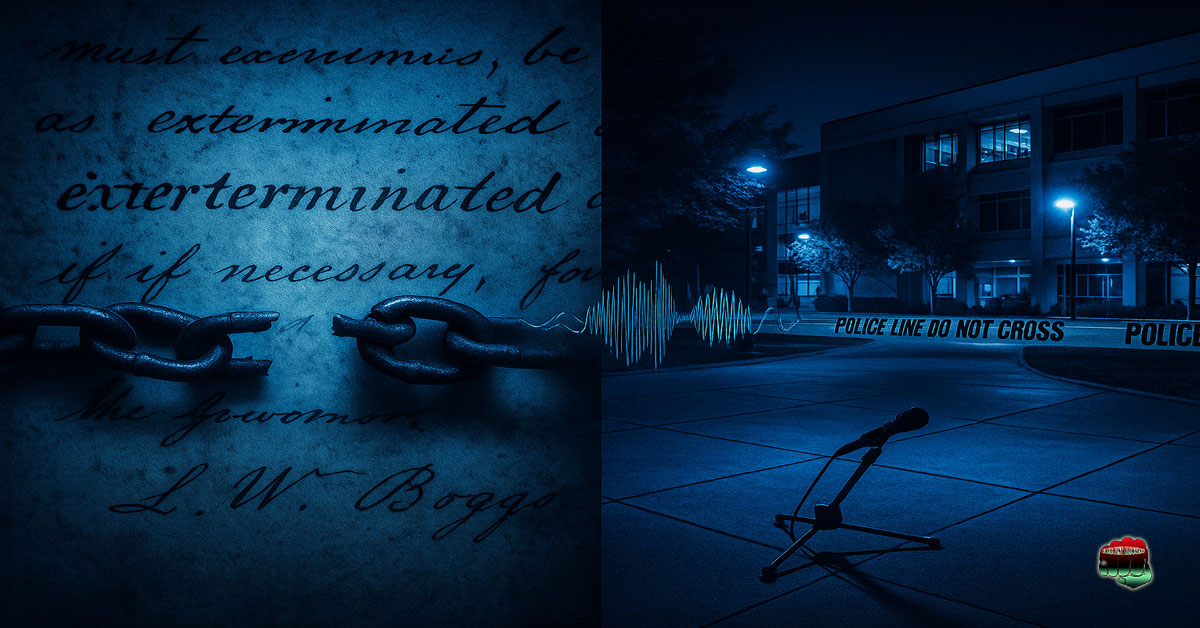From EO-44 to a campus killing, the through-line is how dehumanizing language trains the hand that pulls the trigger.
Analysis | InnerKwest Editorial Team — September 11, 2025 (ET)
Editor’s Note — September 11, 2025: Today marks the anniversary of the September 11 attacks. InnerKwest remembers the victims and first responders. We publish this analysis with renewed commitment to resisting dehumanization in all forms.
Charlie Kirk—conservative media figure, Turning Point USA co-founder, and prominent supporter of President Donald Trump—was shot and killed during a public event at Utah Valley University on September 10, 2025. Utah Gov. Spencer Cox called it a “political assassination,” and the manhunt continues. National outlets report a single rooftop shot that struck Kirk as he addressed roughly 3,000 attendees. Political leaders across parties condemned the killing. (Reuters)
Utah is not just another stop on a national culture-war tour. It is home to a people whose collective memory includes being officially targeted by state power. In 1838, Missouri’s governor signed an order authorizing the extermination or expulsion of Latter-day Saints. Words that label whole communities as enemies carry consequences—in 1838 and now. (Wikipedia)
Missouri’s DNA: Slavery as Operating System
To understand Executive Order 44, you must understand Missouri’s political genome. Missouri entered the Union in 1821 as a slave state under the Missouri Compromise—a hard bargain that preserved Senate balance by pairing Missouri with free-state Maine and allowing slavery below the 36°30′ line. That compromise—and the politics required to defend it—shaped Missouri’s institutions and habits of power. (National Archives)
A generation later, Dred Scott, an enslaved Missourian, sued for freedom in St. Louis. The case rose to the U.S. Supreme Court, which in 1857 not only denied Scott’s citizenship but struck down the Missouri Compromise itself, entrenching slaveholder “property rights” in the territories. The origin story of that decision—Missouri courts and Missouri law—underscores the state’s role in codifying human hierarchy. This is the milieu out of which Executive Order 44 emerged. (National Archives)
These aren’t disconnected dots: Missouri’s admission as a slave state, the Border Ruffians who crossed into Kansas to enforce pro-slavery outcomes, and a legal culture willing to deny Black citizenship are all part of the same operating logic—that power can define a class of people out of rights and then use the state to make that definition real. (Wikipedia)
The Order in Black and White
On October 27, 1838, Gov. Lilburn W. Boggs issued Executive Order 44, directing that “the Mormons must be treated as enemies, and must be exterminated or driven from the State if necessary, for the public peace.” The original document is preserved by the Missouri State Archives; it remained on the books until June 25, 1976, when Gov. Christopher S. “Kit” Bond rescinded it as incompatible with basic constitutional rights. (Missouri Secretary of State)
Three days after the order, a militia/vigilante force attacked Haun’s (Hawn’s) Mill, killing 17 Latter-day Saint men and boys. Whether each attacker had read the order is secondary; the state license to treat a religious minority as an enemy population was unmistakable. (Wikipedia)
InnerKwest stance: We reject “softening” the language. “Exterminated” is what the order says. It authorized lethal or expulsive force against a named religious community and provided official cover for dispossession and flight. That is the record—black-letter and blood-letter—and the tardy rescission in 1976 only confirms how long Missouri’s political culture tolerated it. (Missouri Secretary of State)
Utah’s Lived Memory and the Duty of Care
Utah is the headquarters of The Church of Jesus Christ of Latter-day Saints and retains a large LDS share of its adult population (recent surveys commonly place it near the one-half mark). For many families, Missouri, winter exodus, and Haun’s Mill are not museum topics but grandmother stories. When national figures deploy dehumanizing frames or “enemy people” language on Utah stages, they aren’t jousting with abstractions—they’re touching a live wire. (The Salt Lake Tribune)
Yesterday’s Killing, Today’s Reckoning
Authorities say Kirk was felled by a single shot fired from a nearby rooftop during his outdoor appearance at UVU; two people were briefly detained and released, and the suspect remains at large. Gov. Cox labeled it a political assassination. None of this blurs a non-negotiable: political murder is an attack on the public square itself. (Reuters)
But truths can stand side by side. Speech is free; consequences are real. A brand built on provocation carries a heightened duty of care—one informed by where you are and whom you are addressing. That is not victim-blaming; it is a structural critique of a politics that monetizes escalatory framing until some edge-case hears a green light. (Reuters)
Missouri’s Order as a Case Study in License
Defenders sometimes argue that in 19th-century usage “exterminate” could mean “drive out.” Even granting that narrower gloss, the order explicitly licensed the removal of a people by force—and made lethal outcomes “necessary” if resistance appeared. It created a permissive environment for atrocities (Haun’s Mill) and a winter of mass displacement. The state’s 1976 rescission does not absolve; it admits that Missouri sanctioned a crime against a minority. (Wikipedia)
This is the same moral architecture that once defined Black Americans as non-citizens in Dred Scott, protected slave property, and treated border violence as a political tool. Missouri’s Extermination Order is not an aberration; it is of a piece with a slave-state worldview that encoded hierarchy and authorized the state to enforce it. Never forget that lineage. (National Archives)
InnerKwest to the “Neutral Historian”
We refuse the laundering:
- Not a frontier misunderstanding. EO-44 is a state order to eliminate a religious presence—lethally “if necessary.” (Missouri Secretary of State)
- Not “everyone’s fault.” The signer of the order owns its effects; the state owns the consequences it licenses.
- Not separable from slavery. Missouri’s admission as a slave state, its enforcement culture along the Kansas border, and Dred Scott prove a deep pattern: defining classes of people out of rights and using government to make that stick. (National Archives)
History is not a scoreboard; it’s an early-warning system. Once leaders or influencers change how the public names a group, they change what some listeners feel permitted to do to that group.
Utah’s Risk Map in 2025 (and What Responsibility Looks Like)
Even as Utah diversifies, LDS culture remains central to its civic life. That culture carries a trauma map: expulsion, massacre, migration. Ignore it and you don’t just risk offense—you risk activating edge cases who interpret combat-coded rhetoric as a call to action. That risk exists across ideologies: whenever we normalize dehumanization, the danger surface expands. (Yahoo)
So what does responsible conduct look like?
- Drop “enemy people” framing. Debate policies, not the personhood of whole communities.
- Know the ground. A rally in Orem is not a rally in Orlando; Utah’s history changes the stakes. (The Salt Lake Tribune)
- Stop laundering escalation as irony. Snide calls are still calls once memefied.
- Condemn violence without add-ons. No hedging; no whatabouts. (Utah’s governor modeled this clearly.) (The Washington Post)
Receipts You Can’t Edit Away
- EO-44 text & image (Oct 27, 1838) — “must be exterminated or driven from the State.” Missouri State Archives. (Missouri Secretary of State)
- Rescission (June 25, 1976) — Gov. Kit Bond annuls EO-44 as unconstitutional. Missouri State Archives PDF. (Missouri Secretary of State)
- Haun’s Mill (Oct 30, 1838) — 17 killed; militia/vigilante assault. (Foundational summaries and document sets.) (Wikipedia)
- Slave-state DNA — Missouri admitted as slave state in 1821; the Missouri Compromise framework and later Dred Scott originate in Missouri courts and law. (National Archives)
- Kirk killing (Sept 10, 2025) — Fatal shooting at UVU; governor calls it a “political assassination”; suspect at large. (Reuters)
InnerKwest Bottom Line
Missouri’s Extermination Order is not a museum curiosity; it’s a mirror. It reflects a slave-state logic that defined groups out of rights and used government to enforce that definition. Utah’s 2025 tragedy shows how, in a polarized, monetized outrage economy, some individual will eventually take the final step from words to weapon.
Political violence is unacceptable—full stop. And anyone with a platform—left, right, or otherwise—owes the public more than clicks. They owe restraint, place-literacy, and a refusal to resurrect a very old American habit: turning neighbors into enemies because the state—or a megaphone—told them to.
Support InnerKwest: Powering Truth & Excellence with Bitcoin
At InnerKwest.com, we are committed to delivering impactful journalism, deep insights, and fearless social commentary. Your Bitcoin contributions help us execute with excellence, ensuring we remain independent and continue to amplify voices that matter.
Support our mission—send BTC today!
🔗 Bitcoin Address: 3NM7AAdxxaJ7jUhZ2nyfgcheWkrquvCzRm© 2026 InnerKwest®. All Rights Reserved | Haki zote zimehifadhiwa | 版权所有.
InnerKwest® is a registered trademark of Performance Platforms Global Inc.
No part of this publication may be reproduced, distributed, or transmitted in any form or by any means without prior written permission. Unauthorized use is strictly prohibited.
Thank you for standing with us in pursuit of truth and progress!![]()


